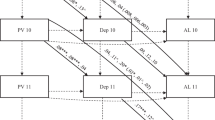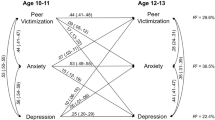Abstract
Many heterosexual youth report homophobic victimization but there is little longitudinal research to examine its mental health consequences for them. In a 7-month study across an academic school year among 572 heterosexual high school students (55 % females), we tested the short-term effects of homophobic victimization on anxiety and depressive symptoms with attention to gender differences. Homophobic victimization at the beginning of the school year predicted higher levels of concurrent anxiety over and above levels attributable to general victimization. Further, when controlling for initial anxiety and general victimization, homophobic victimization at the beginning of the school year predicted increased anxiety at the end of the school year for males, but not for females. Homophobic victimization across time points was more strongly associated for males than females, and this accounted for why initial homophobic victimization predicted increased anxiety for males but not females (i.e., it was indicative of mediated moderation). In contrast, homophobic victimization at the beginning of the school year did not predict concurrent depressive symptoms over and above general victimization. Similarly, although it predicted increased depressive symptoms at the end of the school year for males but not for females, the effect was weaker than for anxiety. These findings underscore that the effects of homophobic victimization are not temporary, particularly as they pertain to anxiety, and underscore the need to consider the nature of the victimization that youth experience, including for heterosexual youth.

Similar content being viewed by others
Notes
Although an argument could be made for an alternative model in which Time 2 mental health predicts Time 2 homophobic victimization, this does not have a basis in theory or empirical findings related to homophobic victimization. The minority stress model posits that stressors (e.g., homophobic victimization) predict mental health outcomes (e.g., depressive symptoms or anxiety). Further, most youth report they experience homophobic victimization because of their perceived sexual orientation, gender norm violations, or because the aggressor wishes to intensify the aggressive act (Pascoe, 2007; Phoenix et al., 2003; Plummer, 2001; Russell et al., 2012). There is virtually no evidence that youth experience homophobic victimization on account of diminished mental health. Furthermore, in the present data Time 1 mental health was not associated with Time 2 homophobic victimization, which converges with these reports. Whereas youth who experience mental health concerns can face stigmatization and victimization on account of these concerns, there is little reason to suspect that that the victimization that these youth experience would be homophobic in nature. Further, our items for homophobic victimization ask students about victimization based on actual or perceived sexual orientation. These are the conceptual and empirical foundations on which we base our proposed model.
References
Aiken, L. S., & West, S. G. (1991). Multiple regression: Testing and interpreting interactions. Newbury Park, CA: Sage.
Crick, N. R., & Bigbee, M. A. (1998). Relational and overt forms of peer victimization: A multi-informant approach. Journal of Consulting and Clinical Psychology, 66, 337–347.
D’Augelli, A. R., Grossman, A. H., & Starks, M. T. (2006). Childhood gender atypicality, victimization, and PTSD among lesbian, gay, and bisexual youth. Journal of Interpersonal Violence, 21, 1462–1482. doi:10.1177/0886260506293482.
D’Augelli, A. R., Pilkington, N. W., & Hershberger, S. L. (2002). Incidence and mental health impact of sexual orientation victimization of lesbian, gay, and bisexual youths in high school. School Psychology Quarterly, 17, 148–167.
Kimmel, M. S. (1997). Masculinity as homophobia: Fear, shame, and silence in the construction of gender identity. In M. M. Gergen & S. N. Davis (Eds.), Toward a new psychology of gender (pp. 223–242). Florence, KY: Taylor & Frances.
Liu, R. T., & Mustanski, B. (2012). Suicidal ideation and self-harm in lesbian, gay, bisexual, and transgender youth. American Journal of Preventive Medicine, 42, 221–228. doi:10.1016/j.amepre.2011.10.023.
Lovibond, P. F., & Lovibond, S. H. (1995). The structure of negative emotional states: Comparison of the Depression Anxiety Stress Scales (DASS) with the Beck Depression and Anxiety Inventories. Behaviour Research and Therapy, 33, 335–343.
Mahalik, J. R., Morray, E. S., Coonerty-Femiano, A., Ludlow, L. H., Slattery, S. M., & Smiler, A. (2005). Development of the conformity to feminine norms inventory. Sex Roles, 52, 417–435.
Meyer, I. H. (2003). Prejudice, social stress, and mental health in lesbian, gay, and bisexual populations: Conceptual issues and research evidence. Psychological Bulletin, 129, 674–697. doi:10.1037/0033-2909.129.5.674.
Muller, D., Judd, C. M., & Yzerbyt, V. Y. (2005). When moderation is mediated and mediation is moderated. Journal of Personality and Social Psychology, 89, 852–863.
Mynard, H., & Joseph, S. (2000). Development of the multidimensional peer-victimization scale. Aggressive Behavior, 26, 169–178.
Mynard, H., Joseph, S., & Alexander, J. (2000). Peer-victimisation and posttraumatic stress in adolescents. Personality and Individual Differences, 29, 815–821.
Pascoe, C. J. (2007). Dude, you’re a fag: Masculinity and sexuality in high school. Los Angeles, CA: University of California Press.
Phoenix, A., Frosh, S., & Pattman, R. (2003). Producing contradictory masculine subject positions: Narratives of threat, homophobia, and bullying in 11–14 year old boys. Journal of Social Issues, 59, 179–195.
Plummer, D. C. (2001). The quest for modern manhood: Masculine stereotypes, peer culture and the social significance of homophobia. Journal of Adolescence, 24, 15–23.
Poteat, V. P., & DiGiovanni, C. D. (2010). When biased language use is associated with bullying and dominance: The moderating effect of prejudice. Journal of Youth and Adolescence, 39, 1123–1133. doi:10.1007/s10964-010-9565-y.
Poteat, V. P., & Espelage, D. L. (2007). Predicting psychosocial consequences of homophobic victimization in middle school students. Journal of Early Adolescence, 27, 175–191.
Poteat, V. P., Mereish, E. H., DiGiovanni, C. D., & Koenig, B. W. (2011). The effects of general and homophobic victimization on adolescents’ psychosocial and educational concerns: The importance of intersecting identities and parental support. Journal of Counseling Psychology, 58, 597–609. doi:10.1037/a0025095.
Poteat, V. P., O’Dwyer, L. M., & Mereish, E. H. (2012). Changes in how students use and are called homophobic epithets over time: Patterns predicted by gender, bullying, and victimization status. Journal of Educational Psychology, 104, 393–406.
Rivers, I. (2001). The bullying of sexual minorities at school: Its nature and long-term correlates. Educational and Child Psychology, 18, 32–46.
Robinson, J. P., Espelage, D. L., & Rivers, I. (2013). Developmental trends in peer victimization and emotional distress in LGB and heterosexual youth. Pediatrics, 131, 423–430.
Rosario, M., Schrimshaw, E. W., Hunter, J., & Gwadz, M. (2002). Gay-related stress and emotional distress among gay, lesbian and bisexual youths: A longitudinal examination. Journal of Consulting and Clinical Psychology, 70, 967–975.
Rubin, K., Bukowski, W. M., & Parker, J. G. (2006). Peer interactions, relationships, and groups. In N. Eisenberg (Vol. Ed.), W. Damon, R. M. Lerner (Series Eds.), Handbook of child psychology: Vol. 3. Social, emotional, and personality development (6th ed., pp. 571–645). New York: Wiley.
Russell, S. T., Sinclair, K. O., Poteat, V. P., & Koenig, B. W. (2012). Adolescent health and harassment based on discriminatory bias. American Journal of Public Health, 102, 493–495. doi:10.2105/AJPH.2011.300430.
Swearer, S. M., Turner, R. K., Givens, J. E., & Pollack, W. S. (2008). “You’re so gay!”: Do different forms of bullying matter for adolescent males? School Psychology Review, 37, 160–173.
Woodford, M. R., Howell, M. L., Silverschanz, P., & Yu, L. (2012). “That’s so gay!”: Examining the covariates of hearing this expression among gay, lesbian, and bisexual college students. Journal of American College Health, 60, 429–434.
Author contributions
VP conceived of the study and its design, conducted the analyses, and drafted the manuscript; JS contributed to the conceptualization of the paper and drafted the manuscript; CD and EM contributed equally and aided in the interpretation of the analyses and edits to the manuscript.
Author information
Authors and Affiliations
Corresponding author
Rights and permissions
About this article
Cite this article
Poteat, V.P., Scheer, J.R., DiGiovanni, C.D. et al. Short-Term Prospective Effects of Homophobic Victimization on the Mental Health of Heterosexual Adolescents. J Youth Adolescence 43, 1240–1251 (2014). https://doi.org/10.1007/s10964-013-0078-3
Received:
Accepted:
Published:
Issue Date:
DOI: https://doi.org/10.1007/s10964-013-0078-3




